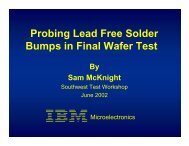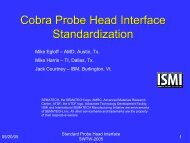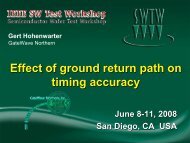One Touch 300 mm wafer probing - Semiconductor Wafer Test ...
One Touch 300 mm wafer probing - Semiconductor Wafer Test ...
One Touch 300 mm wafer probing - Semiconductor Wafer Test ...
Create successful ePaper yourself
Turn your PDF publications into a flip-book with our unique Google optimized e-Paper software.
<strong>One</strong> <strong>Touch</strong> <strong>300</strong> <strong>mm</strong> <strong>wafer</strong> <strong>probing</strong><br />
Sunil Wijeyesekera<br />
June 14, 2006
Synopsis<br />
The problems encountered with 1 TD <strong>300</strong> <strong>mm</strong><br />
<strong>wafer</strong> <strong>probing</strong> are unique enough that an approach<br />
that simply scales up traditional probe card<br />
architecture and industry practice is not sufficient.<br />
To resolve the specific setup and throughput issues<br />
associated with 1 TD requires a systems level<br />
approach where probe card, prober and tester<br />
vendors work collaboratively to solve customer<br />
problems.<br />
Sunil Wijeyesekera<br />
June 13, 2006<br />
<strong>One</strong> <strong>Touch</strong> <strong>300</strong> <strong>mm</strong> <strong>Wafer</strong> Probing<br />
FormFactor<br />
Southwest <strong>Test</strong> Workshop, pg 2
1TD Probing Process Challenges<br />
1TD Challenges<br />
Co-Planarity across wide area<br />
High <strong>probing</strong> forces<br />
<strong>Test</strong>cell Productivity and Xput<br />
Setup times, thermal behavior<br />
Maintenance, debug and repair<br />
Impact on Probing<br />
More Adjustments or Yield Loss<br />
Setup issues (x/y alignment)<br />
More maintenance (cleaning<br />
change out)<br />
More planarity adjusts risk<br />
opens/ Cres<br />
Back-up testers and probecards<br />
Sunil Wijeyesekera<br />
June 13, 2006<br />
<strong>One</strong> <strong>Touch</strong> <strong>300</strong> <strong>mm</strong> <strong>Wafer</strong> Probing<br />
FormFactor<br />
Southwest <strong>Test</strong> Workshop, pg 3
<strong>300</strong><strong>mm</strong> 1TD challenges –<br />
Planarity & Tilt<br />
δ Intrinsic<br />
δ 150<br />
150 <strong>mm</strong> 150 <strong>mm</strong><br />
δ = 2x <strong>300</strong> δ<br />
150<br />
Chuck<br />
Long Scrubs (more damage)<br />
Low Cres, Higher Probing Force<br />
Short Scrubs (less damage)<br />
High Cres, Lower Probing Force<br />
To maintain spec, we have to be<br />
2 x better than we have been before<br />
Sunil Wijeyesekera<br />
June 13, 2006<br />
<strong>One</strong> <strong>Touch</strong> <strong>300</strong> <strong>mm</strong> <strong>Wafer</strong> Probing<br />
FormFactor<br />
Southwest <strong>Test</strong> Workshop, pg 4
Problems impacted by planarity<br />
and tilt<br />
Planarity correlation between customer and supplier.<br />
<strong>Test</strong> floor to test floor correlation – cards are shipped between sites.<br />
<strong>Test</strong> system to test system correlation – on a single test floor<br />
Adjustment rate (relative)<br />
PH75 PH100 PH150<br />
<strong>300</strong> <strong>mm</strong> 1 TD predicted to be at least 2 x adjustment rate of PH150<br />
Sunil Wijeyesekera<br />
June 13, 2006<br />
<strong>One</strong> <strong>Touch</strong> <strong>300</strong> <strong>mm</strong> <strong>Wafer</strong> Probing<br />
FormFactor<br />
Southwest <strong>Test</strong> Workshop, pg 5
How to address planarity and tilt<br />
• System to system correlation<br />
• Usually carried out using a “standard” that is measured<br />
across the floor.<br />
• Glass mask<br />
• Golden probe card.<br />
• Ceramic probe card.<br />
• Issues with correlation<br />
• Extensive Time and work required.<br />
• System downtime.<br />
• Repeatability and accuracy.<br />
• In-situ tilt control<br />
• Issues with this method<br />
• Automation has not traditionally been available<br />
• Card often has to be pulled out of the prober to adjust, while<br />
measurement is done inside the prober.<br />
Sunil Wijeyesekera<br />
June 13, 2006<br />
<strong>One</strong> <strong>Touch</strong> <strong>300</strong> <strong>mm</strong> <strong>Wafer</strong> Probing<br />
FormFactor<br />
Southwest <strong>Test</strong> Workshop, pg 6
Results of System Level tilt<br />
control on a 1 TD card<br />
Tilt + pin-to-pin variation<br />
100<br />
Pin-to-pin variation<br />
100<br />
y<br />
50<br />
0<br />
-50<br />
Planarity<br />
1TD Probing Process Challenges<br />
1TD Challenges<br />
Co-Planarity across wide area<br />
High <strong>probing</strong> forces<br />
<strong>Test</strong>cell Productivity and Xput<br />
Setup times, thermal behavior<br />
Maintenance, debug and repair<br />
Impact on Probing<br />
More Adjustments or Yield Loss<br />
Setup issues (x/y alignment)<br />
More maintenance (cleaning<br />
change out)<br />
More planarity adjusts risk<br />
opens/ Cres<br />
Back-up testers and probecards<br />
Sunil Wijeyesekera<br />
June 13, 2006<br />
<strong>One</strong> <strong>Touch</strong> <strong>300</strong> <strong>mm</strong> <strong>Wafer</strong> Probing<br />
FormFactor<br />
Southwest <strong>Test</strong> Workshop, pg 8
<strong>300</strong><strong>mm</strong> 1TD challenges –<br />
High Probe Force<br />
This is a big jump in force over current products<br />
Product Type<br />
Springs<br />
/DUT<br />
# of<br />
DUTs<br />
Springs<br />
Low<br />
Force<br />
Spring<br />
Kg<br />
High<br />
Force<br />
Spring<br />
Kg<br />
Nand Flash 25 500 12,500 63 125<br />
NOR Flash 40 800 32,000 160 320<br />
DRAM #1 75 500 37,500 188 375<br />
DRAM #2 75 1000 75,000 375 750<br />
* Low spring force is 5 grams per contact<br />
Sunil Wijeyesekera<br />
June 13, 2006<br />
<strong>One</strong> <strong>Touch</strong> <strong>300</strong> <strong>mm</strong> <strong>Wafer</strong> Probing<br />
FormFactor<br />
Southwest <strong>Test</strong> Workshop, pg 9
<strong>300</strong><strong>mm</strong> 1TD challenges –<br />
High Probe Force<br />
Progra<strong>mm</strong>ed overtravel<br />
100<br />
80<br />
60<br />
40<br />
20<br />
4 repeat measurements<br />
Ideal situation - no system<br />
compliance<br />
Data from card with<br />
7<strong>300</strong> probes<br />
0<br />
0 20 40 60 80 100<br />
Actual overtravel<br />
System deflection results in 35 % loss of effective spring<br />
compression<br />
Sunil Wijeyesekera<br />
June 13, 2006<br />
<strong>One</strong> <strong>Touch</strong> <strong>300</strong> <strong>mm</strong> <strong>Wafer</strong> Probing<br />
FormFactor<br />
Southwest <strong>Test</strong> Workshop, pg 10
<strong>300</strong><strong>mm</strong> 1TD challenges –<br />
High Probe Force<br />
Compliance Contributions<br />
Short scrub<br />
Long scrub<br />
Measured using split<br />
photodiode<br />
Unbalanced loading leads to horizontal system compliance<br />
Sunil Wijeyesekera<br />
June 13, 2006<br />
<strong>One</strong> <strong>Touch</strong> <strong>300</strong> <strong>mm</strong> <strong>Wafer</strong> Probing<br />
FormFactor<br />
Southwest <strong>Test</strong> Workshop, pg 11
Methods for adjusting for<br />
system z compliance<br />
Engineering studies on cards with different probe counts<br />
• Platform dependent<br />
• Issues with resolution, accuracy<br />
Add stiffeners to the probe cards<br />
• Adds mass (approaching ergonomic limits)<br />
• The high CTE of the stiffener can cause thermal bending.<br />
• Adds thermal mass, which increases setup times.<br />
• May not fit in space allocated for probe card.<br />
• Adds cost<br />
The most effective approach is to look at the<br />
structural rigidity of the system<br />
Sunil Wijeyesekera<br />
June 13, 2006<br />
<strong>One</strong> <strong>Touch</strong> <strong>300</strong> <strong>mm</strong> <strong>Wafer</strong> Probing<br />
FormFactor<br />
Southwest <strong>Test</strong> Workshop, pg 12
Results of minimizing system<br />
compliance<br />
Rigid element attached to tester motherboard<br />
Deflection<br />
Force = 200 kgms<br />
Max Deflection = 3.4 um<br />
Vertical Z Deflection<br />
No Tilt<br />
Sunil Wijeyesekera<br />
June 13, 2006<br />
<strong>One</strong> <strong>Touch</strong> <strong>300</strong> <strong>mm</strong> <strong>Wafer</strong> Probing<br />
FormFactor<br />
Southwest <strong>Test</strong> Workshop, pg 13
1TD Probing Process Challenges<br />
1TD Challenges<br />
Co-Planarity across wide area<br />
High <strong>probing</strong> forces<br />
<strong>Test</strong>cell Productivity and Xput<br />
Setup times, thermal behavior<br />
Maintenance, debug and repair<br />
Impact on Probing<br />
More Adjustments or Yield Loss<br />
Setup issues (x/y alignment)<br />
More maintenance (cleaning<br />
change out)<br />
More planarity adjusts risk<br />
opens/ Cres<br />
Back-up testers and probecards<br />
Sunil Wijeyesekera<br />
June 13, 2006<br />
<strong>One</strong> <strong>Touch</strong> <strong>300</strong> <strong>mm</strong> <strong>Wafer</strong> Probing<br />
FormFactor<br />
Southwest <strong>Test</strong> Workshop, pg 14
<strong>300</strong><strong>mm</strong> 1TD challenges – Uptime<br />
• Baseline – no thermal soak (5 minutes for lot change).<br />
• 30 minute thermal soak<br />
• Realign every 10 minutes for 4 hours – setup only<br />
• Realign every 10 minutes for 4 hours – every lot<br />
Sunil Wijeyesekera<br />
June 13, 2006<br />
<strong>One</strong> <strong>Touch</strong> <strong>300</strong> <strong>mm</strong> <strong>Wafer</strong> Probing<br />
FormFactor<br />
Southwest <strong>Test</strong> Workshop, pg 15
Slow system thermal response<br />
impacts probe position<br />
90<br />
Probe card temperature<br />
40<br />
80<br />
30<br />
70<br />
Temp (deg C)<br />
60<br />
50<br />
40<br />
30<br />
20<br />
Probe tip drift (x,y,z)<br />
20<br />
10<br />
0<br />
-10<br />
Drift (um)<br />
10<br />
-20<br />
0<br />
-30<br />
0 50 100 150 200 250 <strong>300</strong><br />
Time (min)<br />
System continues drifting after probe card reaches thermal equilibrium<br />
Sunil Wijeyesekera<br />
June 13, 2006<br />
<strong>One</strong> <strong>Touch</strong> <strong>300</strong> <strong>mm</strong> <strong>Wafer</strong> Probing<br />
FormFactor<br />
Southwest <strong>Test</strong> Workshop, pg 16
<strong>Test</strong>er – Probe Card – Prober<br />
Thermal Loop<br />
conduction<br />
convection<br />
radiation<br />
TEST HEAD<br />
INSERT RING<br />
STIFFENER<br />
FAN<br />
HEAD<br />
PLATE<br />
CH<br />
WAFER<br />
CHUCK<br />
PROBER<br />
CAVITY<br />
Sunil Wijeyesekera<br />
June 13, 2006<br />
GND<br />
<strong>One</strong> <strong>Touch</strong> <strong>300</strong> <strong>mm</strong> <strong>Wafer</strong> Probing<br />
FormFactor<br />
Southwest <strong>Test</strong> Workshop, pg 17
Thermal Stability Results<br />
<strong>One</strong> TD card designed to minimize system<br />
thermal response<br />
This card carries the potential to remove thermal soak<br />
and realignment times<br />
Sunil Wijeyesekera<br />
June 13, 2006<br />
<strong>One</strong> <strong>Touch</strong> <strong>300</strong> <strong>mm</strong> <strong>Wafer</strong> Probing<br />
FormFactor<br />
Southwest <strong>Test</strong> Workshop, pg 18
Other elements of uptime<br />
Alignment failures<br />
• Special alignment features.<br />
• Minimize thermal realignment.<br />
Cleaning /PM<br />
•Process improvements discussed earlier are all<br />
designed to provide a consistent <strong>probing</strong><br />
process which minimizes cleaning.<br />
Repair<br />
•Minimize repair through improved contactor<br />
design.<br />
•Service close to customer (fast turn times)<br />
Sunil Wijeyesekera<br />
June 13, 2006<br />
<strong>One</strong> <strong>Touch</strong> <strong>300</strong> <strong>mm</strong> <strong>Wafer</strong> Probing<br />
FormFactor<br />
Southwest <strong>Test</strong> Workshop, pg 19
Conclusion<br />
1 TD <strong>probing</strong> is more than a scale up of<br />
previous technologies<br />
System Level approaches are needed to<br />
overcome key <strong>probing</strong> process and<br />
throughput issues.<br />
Sunil Wijeyesekera<br />
June 13, 2006<br />
<strong>One</strong> <strong>Touch</strong> <strong>300</strong> <strong>mm</strong> <strong>Wafer</strong> Probing<br />
FormFactor<br />
Southwest <strong>Test</strong> Workshop, pg 20








